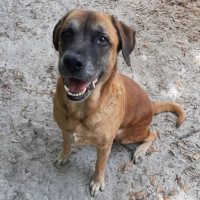Appearance of the Golden Boxer
|
| The Golden Boxer is a hybrid between the Boxer and the Golden Retriever, and can resemble either parent breed depending on dominant appearance. They are large dogs, weighing between 27 and 34 kilos, with a robust, muscular build. If the Golden Boxer leans more towards the Boxer parent, it will have a square-shaped head and a shorter muzzle. If the Golden Boxer leans more towards the Golden Retriever, its head will be round on top and have a longer muzzle. A Golden Boxer's ears are elongated, like those of the Golden Retriever, but have the same perky, inquisitive look. The eyes are light to dark brown and oval-shaped. Feet are medium-sized, round and compact, and the body is muscular. |
Temperament of the Golden Boxer
|
| The Golden Boxer is a high-energy, family-loving hybrid. Unlike the friendly Golden Retriever, the Boxer parent makes this mix slightly wary of strangers. The Golden Boxer can be a good watchdog, and you can expect him to bark at the approach of unfamiliar strangers. Otherwise, the Golden Boxer is quiet. The Golden Boxer is patient and, with good socialization, will do well with children. However, they are a larger, more energetic breed and may not be well suited to living with very young children. Always teach your children how to approach and interact with a dog. Rough play, tail-pulling and teasing should be avoided. The Golden Boxer adapts well to sharing space with other dogs and cats, although the cat's small size and willingness to run away from the Golden Boxer can excite the prey mind, and your Golden Boxer may chase the cat away. Early socialization with other dogs will help a Golden Boxer to live in harmony with other dogs. The Golden Retriever parent is always eager to please, just like the Boxer, making this hybrid a breeze for training and novice dog owners. |
Needs and activities of the Golden Boxer
|
| The Golden Boxer is a hybrid of two breeds with high energy requirements of varying intensity. Your Golden Boxer will need plenty of exercise, but not high-intensity exercise, if it resembles the Golden Retriever. If your Golden Boxer resembles the Boxer, he'll love to jump and needs much more intense exercise. Being a big dog, the Golden Boxer has to run and run hard every day to expel his extra energy. Its high energy level means it's not well suited to apartment and city living. A backyard and running space are more suitable for this hybrid. With discipline, the Golden Boxer is an excellent jogging partner. The Golden Boxer prefers temperate climates, and while it tolerates both hot and cold environments, extremes are not well tolerated. |
Maintenance of the Golden Boxer
|
| The Golden Boxer is not a hypoallergenic dog, and sheds considerably regardless of which parent the hybrid resembles. Twice-weekly grooming by brushing with a smoother brush will help remove dead and loose hairs and keep your Golden Boxer's coat healthy. This mix isn't known for smelling, but weekly grooming will help distribute the oils and remove dirt and dead skin that could lead to a hound-like odor. Frequent nail trimming is also suggested for your Golden Boxer. Golden Boxers don't usually drool, but an increase in drooling may indicate that your Golden Boxer is suffering from a dental or gum problem. Regular brushing and cleaning of the teeth will enable you to check his gums and prevent disease. |









 English (United Kingdom)
English (United Kingdom)